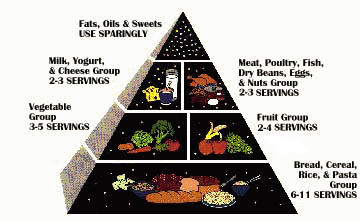

Good source of starchy carbohydrates. Very filling, mostly low in fat.
Includes foods made from flour and grains such as cereals, rice, pasta, and bread.
Less refined foods are better - for example, choose whole wheat toast over white.

|

|
Grains
Good source of starchy carbohydrates. Very filling, mostly low in fat. Includes foods made from flour and grains such as cereals, rice, pasta, and bread. Less refined foods are better - for example, choose whole wheat toast over white. |
|
Fruits & Vegetables
|

|

|

|

|
Meats & Dairy
High in protein, low in carbohydrates. Includes fish, meat, poultry, eggs, milk, cheese, yogurt, nuts. Opt for lean meat, chicken without skin, and low-fat dairy products. Also, nutritionists recommend eating fish at least twice a week. |
|
Fats & Sugars
|

|

|

|
The Food Pyramid was proposed by the US Deparment of Agriculture as a general guide to a healthy diet. Based on the four food groups, the pyramid indicates the amount of servings of each food group you should eat daily. Sparing amount of fats 2-3 servings of dairy / 2-3 servings of meats 3-5 servings of vegetables / 2-4 servings of fruits 6-11 servings of grains |
|
Grains: 1 slice of bread; 1/2 bowl of cereal; 1/2 muffin; 1/2 cup of cooked rice or pasta. Vegetables: 1 cup of raw vegetables; 1/2 cup of cooked or chopped; 3/4 cup of juice. Fruits: 1 medium fresh fruit; 1/2 cup of chopped, cooked, or canned fruit; 3/4 cup of juice. Meats: 2-3 ounces of cooked meat, poultry, or fish; 2 eggs; 1/2 cup of beans or nuts. Dairy: 1 cup of milk or yogurt; 1-1/2 ounces of natural cheese; 2 ounces of process cheese. |

|

|

|
1,600 calories: sedentary women and some older adults. 2,200 calories: most children, teenage girls, active women, and many sedentary men. 2,800 calories: teenage boys, many active men, and some very active women. |
| Grains | |||
| Vegetables | |||
| Fruits | |||
| Meats | |||
| Dairy |
|
There is no magic solution to dieting except this simple logic of weight loss: If you take in more calories than you burn, you gain; if you burn more than you take in, you lose. Thus, you should choose foods that are more filling and nutritious for the same amount of calories, It's good to have some idea of the caloric values of the food you eat (take a look at calorie charts). The key to a balanced diet is consuming a variety of foods to get all the nutrients you need while keeping it under your optimum caloric intake.
Before you get the BigMac and super-size fries, check out the nutrition values of fastfood |

|

|
Back to Top |